Review of Samsung SM961 512GB and 256GB SSD
- Transfer
Samsung SM961 SSD has not yet officially entered the market, and OEM status makes it available on the basis of who first ordered, first served. We have already ordered the main dish SM961 with 1TB of memory to the table, but for now we’ll see a dessert that comes in the form of the two most popular SSD capacities on the market.
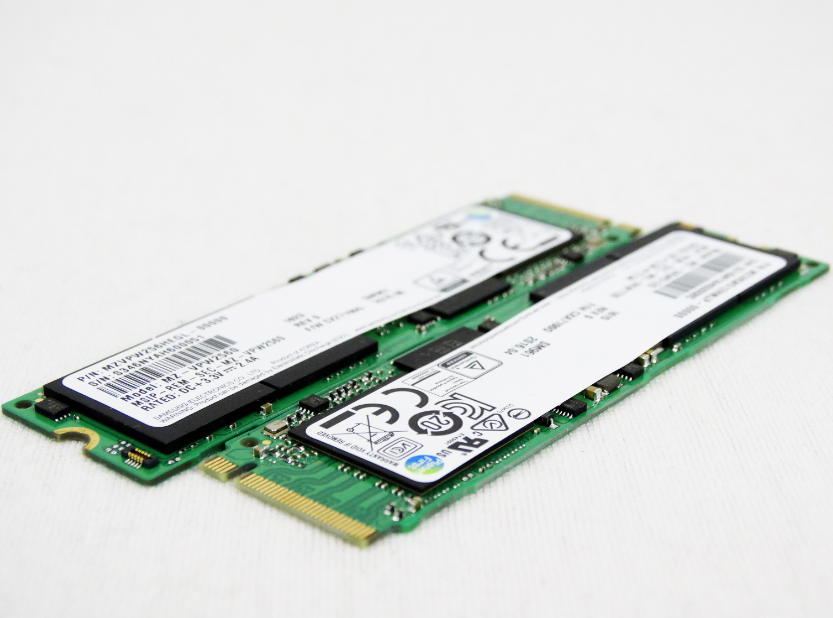
Today we compare the SM961 512GB and 256GB with other NVMe-based products. The two discs that we are testing today are cheaper than the discs on the market, but still they do not dominate in all categories of performance.
Contents
Price, Warranty, and Accessories
Four-Point Performance Testing
Conclusion
Samsung has released the SM961 NVMe SSD for OEMs in four capacities from 128GB to 1024GB (1TB). Of these, we expect that only three will be available, since we think we should not wait for too many sales of SM961 drives with 128GB. Samsung did not release the 128 GB version of the 950 Pro, which made sense, because this product is only for enthusiasts and experienced users.
Samsung's new Polaris controller is at the heart of all SM961 SSDs, paired with a new 48-layer MLC NAND V-shaped memory cell. Many of the 850 EVO SSDs migrated to the NAND's 48-layer TLC VLC memory slot and the T3 portable SSD also comes with it, so this is the first product to ship with Samsung’s latest 3D Flash with MLC. A flash with 48 layers is the first such disk with a capacity of 256 Gbit, and it should reduce the price of existing SSD-drives, and also provides Samsung the ability to make new drives with high bandwidth.
Today we look at the 256GB and 512GB models, which, according to the manufacturer, give higher than 3100 MB / s sequential read speed. The 256GB drive reaches up to 1400 MB / s sequential write speed while 512GB gives up to 1700 MB / s. The arbitrary read speed of the SM961 is 330,000 IOPS, while the random write speed is 280,000 for the 256GB model and 300,000 for the 512GB model.
Samsung SM961 does not produce the department responsible for the 950 Pro and other retail products. It is being developed by the Samsung SSI Group, which makes products for OEMs and major system integrators such as Dell, HP and Lenovo. Large companies get access to SSI products earlier, but over time, SSDs leak through distributors and then to intermediaries. This circuit is commonly known as the “channel”.
Australia, namely Ram City, has a history of launching Samsung SSI products in the retail market. The SM961 256GB sells for $ 159 and the 512GB for $ 280, both of which are cheaper than the price of the flagship 950 Pro, Samsung NVMe's retail product. Pricing SM961 is also tied to the Australian dollar, so prices are subject to change. The prices that we give in this article were given to us before considering the SM961 with 1TB. Since then, the Australian dollar has lost 10 percent against the US dollar, thus making SM961 SSDs cheaper for US buyers.
Ram City sells the SM961 with a 3-year warranty, but since this is an OEM product, it does not come in the Samsung retail package and does not include any accessories. The company wraps the discs in an antistatic bag that goes inside a cardboard box with a foam lining. Delivery from Australia to my office in Indiana takes three to five days, depending on what time I placed the order before or after the weekend.
Gaze
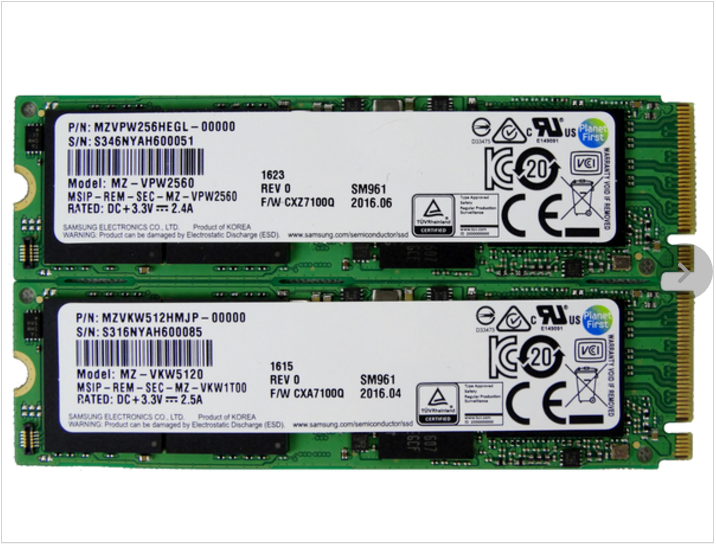

All three SM961 drives we tested use the same configuration with the new Samsung Polaris controller and two NAND flash packages. Samsung just changes the amount in the package to adjust the power. The discs are all one-sided so that they fit in the thinnest spaces. Some of the new laptops only support one-sided design, as the M.2 connector sits very close to the motherboard. Drives are 80 mm long, also known as M.2 2280. The marking “2280” indicates the width (22mm) and depth (80 mm) of the SSD.
Compared Models
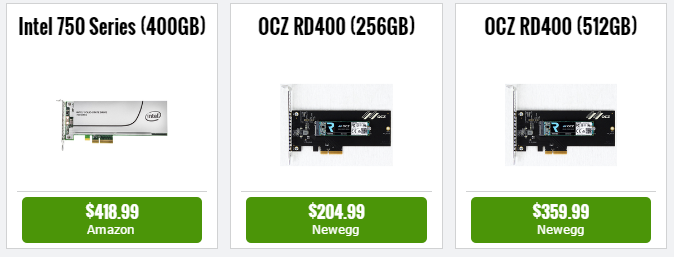
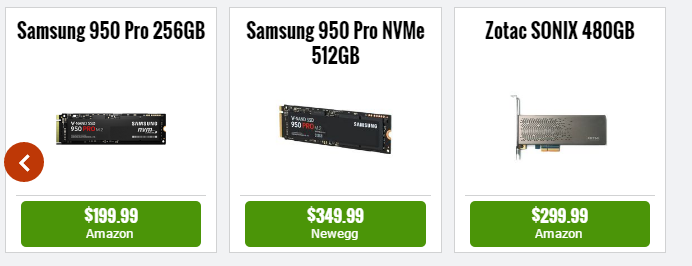
Intel 750 Series (400GB), OCZ RD400 (256GB), OCZ RD400 (512GB), Samsung 950 Pro 256GB, Samsung 950 Pro NVMe 512GB, Zotac SONIX 480GB
In this review, we focused solely on the 256 and 512 NVMe SSDs GB Such a selection will make it easier to compare the presented drives. We did not compare the SM951 model and instead give the results of the very close 950 Pro model in performance.
Both Intel and OCZ (a division of Toshiba) sell products that fall within this power range, but Intel only offers 750 SSDs at 400GB (along with 800GB and 1200GB models are not present in our graphics). Zotac Sonix has a Phison PS5007-E7 controller with 15nm Toshiba MLC NAND. Currently, the only retail SSD is available with an E7 controller.
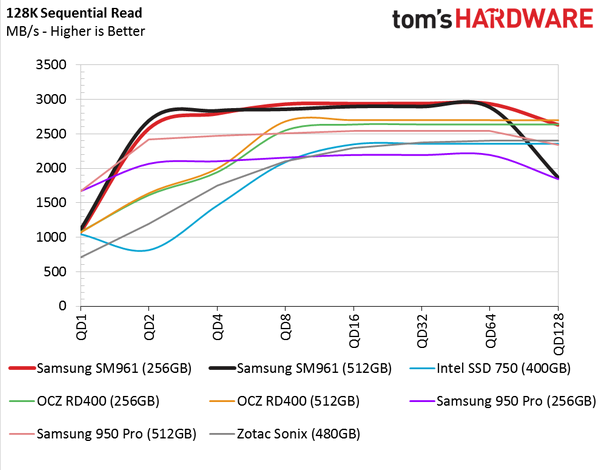
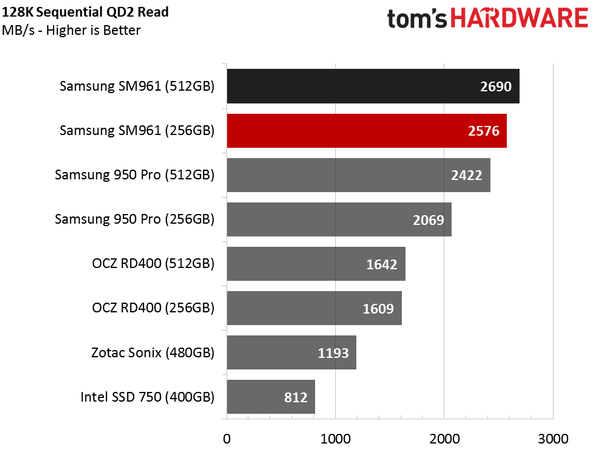
Both SM961 SSDs deliver impressive sequential read performance that outperforms all other products in the charts, with the 1TB model doing the same. Close results are not surprising; Samsung lists all four SM961 SSDs with a difference of only 100 MB / s in workload.
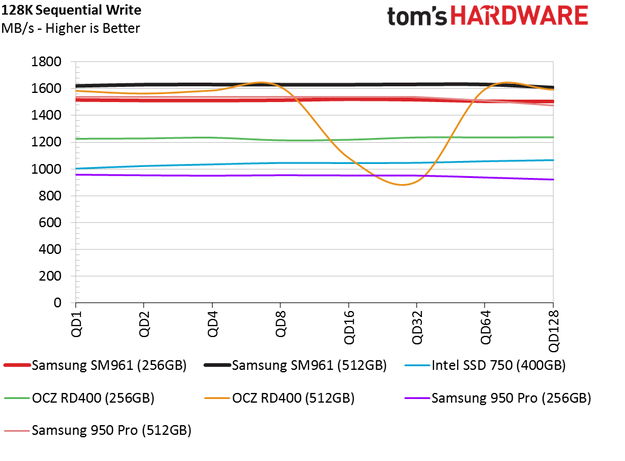
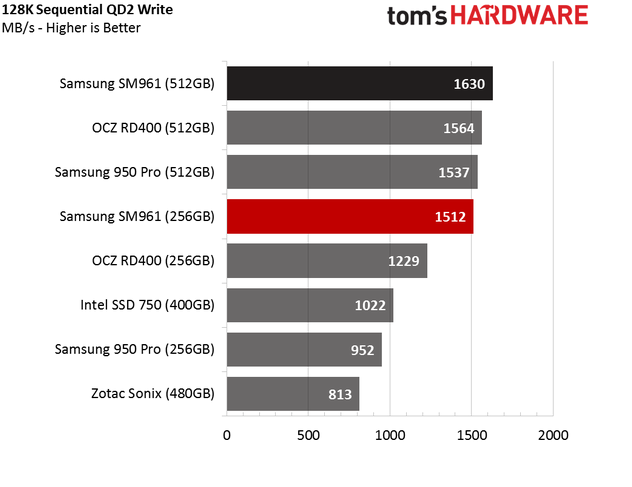
The 512GB OCZ RD400 is the only graphics product that can run at the same high sequential write speeds as the SM961. The diagram also shows the RD400 with a wild drop in performance halfway through the test. The failure was due to thermal protection, but the issue of thermal protection for SM961 is clearly resolved.
Samsung SM961 256GB speed was 1400 MB / s, which is only 300 MB / s less than the 512GB model. The SM961 256GB works much better than advertised, so the difference between the two products is much smaller than expected.
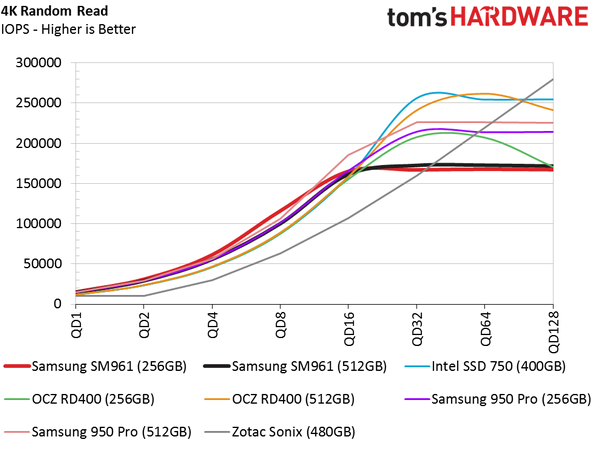
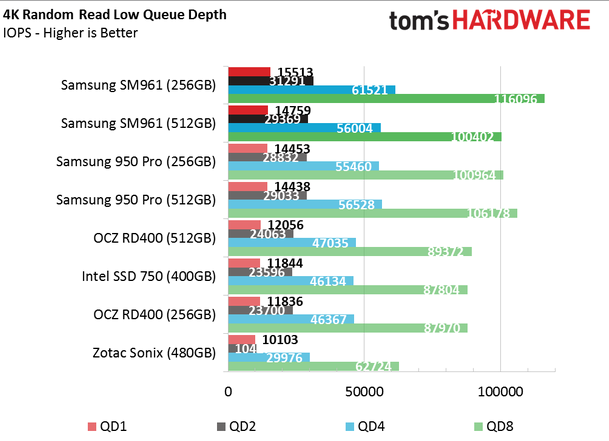
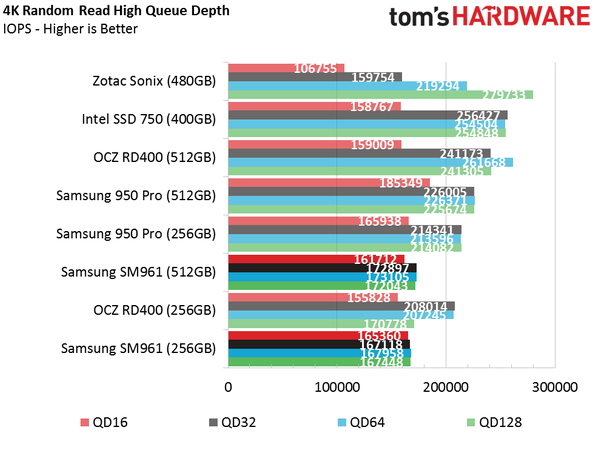
In the SM961, SSDs raise the bar at arbitrary read speeds at shallow queue depths, and we get only a small performance boost over the 950 Pro. The SM961 hits a brick wall with about 170,000 IOPS at high queue depths. An unexpected limit led us to think that Samsung limits the performance of the firmware. We read reports about some SM961 SSDs with more than 500,000 random read IOPS by increasing the number of threads and queue depth to 256. Using multiple workers (threads) exposes several queues, but this is not a comparison of apples and apples.
Host software places external I / O requests, they add up and wait in line for service. When the request is completed, the SSD controller places the final part in the completion queue. The NVMe protocol supports up to 64,000 queues per device, and up to 64,000 commands can be added to each. The SSD maker ultimately determines how many queues and how many teams each SSD will support (they may vary). Samsung may use multiple lines at shallower depths, which might explain the early performance plateau.

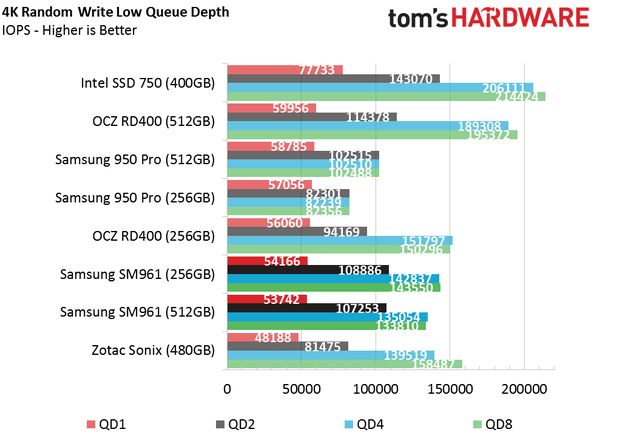

In the SM961, products also have a sharp plateau in the random write test. The limit comes much earlier, in this test, with a queue depth of 4. Of our four tests, random recording gives the SM961 the most trouble. This test is one workload where the new Samsung NVMe SSD cannot surpass the previous generation.
80 Percent of sequential mixed load
Our mixed load testing is described in detail here , and our tests are described here.

Even though the SM961 has the advantage of 100% sequential tests, it significantly loses them compared to mixed serial data. In the past, we have already seen this type of behavior that changes after a firmware update to increase mixed workload performance. The SM961 SSDs are still in the production stage, and we are testing with the first mass firmware. Samsung usually does not release small updates, so when a new firmware is released it will ship immediately with several updates.
Samsung SM and PM series firmware updates create other problems when buying a bare disk. Users usually receive updates from HP or Lenovo . These updates are not advertised using traditional means. As a rule, users can stumble upon an update, and then exchange information in a technical forum.
80 Percent Arbitrary Mixed Load

The SM961 256GB and 512GB perform much better with mixed arbitrary loads compared to other drives. The advantage in random read performance at shallow queue depth is evident during this test. At large queue depths, we see a performance limitation, it comes into play again only at queue depth of 16, while Intel 750 performance continues to scale. The Intel 750 uses a 9-channel controller designed for corporate use, so the result is not surprising.
Consistent stable state
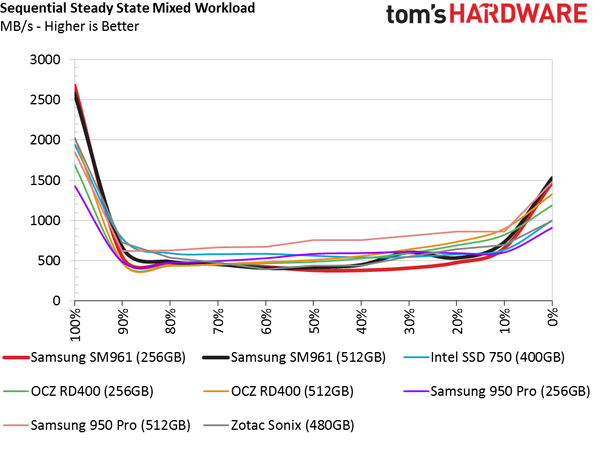
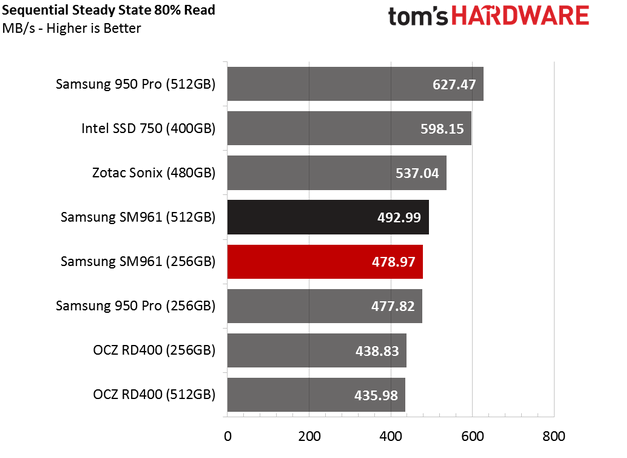
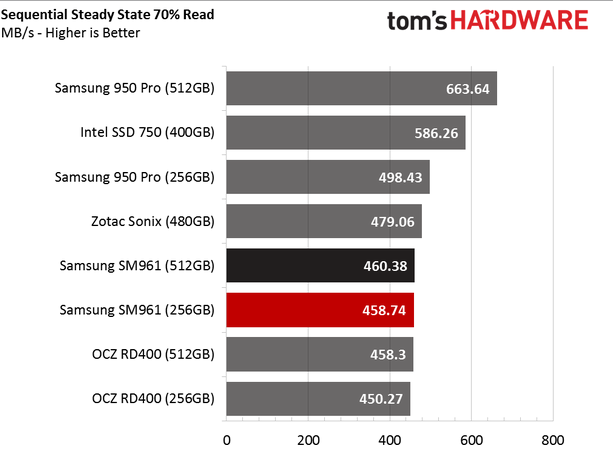
The consistent steady state test shows us that Samsung’s 3D 48-layer flash provides nearly identical performance for older 32-layer flash drives. In this test, we put a lot of burden on the flash to examine the ability of the disk to process new data about dirty cells. Immersing the SSD in a stable state launches its cleaning algorithms, during such a long intensive use you can see its performance.
The SM961 and 950 Pro are devoid of any significant spare areas required for Over-Provisioning (OP). The 950 Pro 512GB delivers the highest performance in this test, but only by a small margin. The 950 Pro 512GB has twice the number of NANDs compared to the SM961 512GB, which gives it the advantage of greater concurrency and improves its performance.
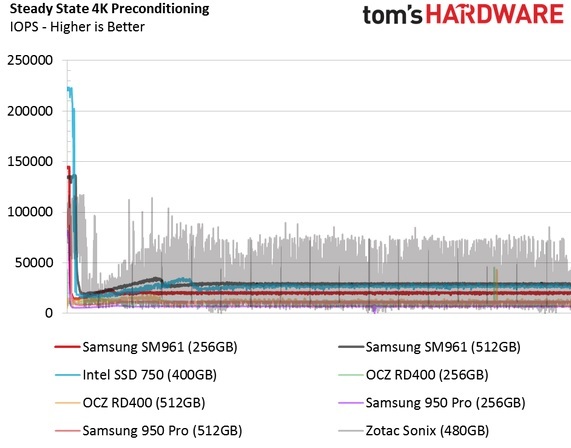
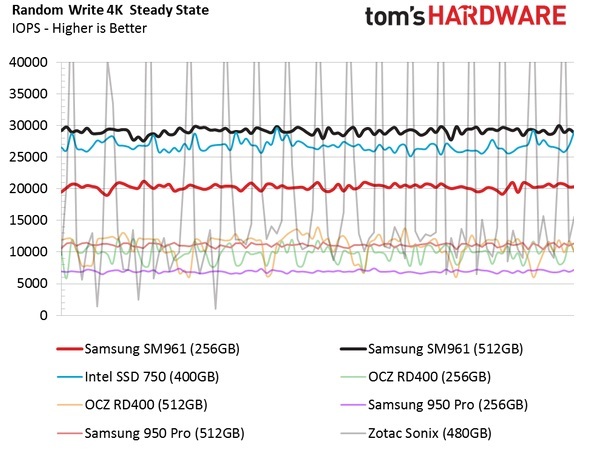
The SM961 512GB SSD delivers the fastest recording performance of stationary 4KB random numbers. Zotac Sonix has 480GB peaks at a higher speed, but it cannot support performance for a very long time; it also drops severely after steady use. The Intel SSD 750 takes place between the two SM961 drives while the 256GB SM961 is located behind it.
PCMark 8 Real-World Performance Software
For more information on software performance testing methods, please click here .
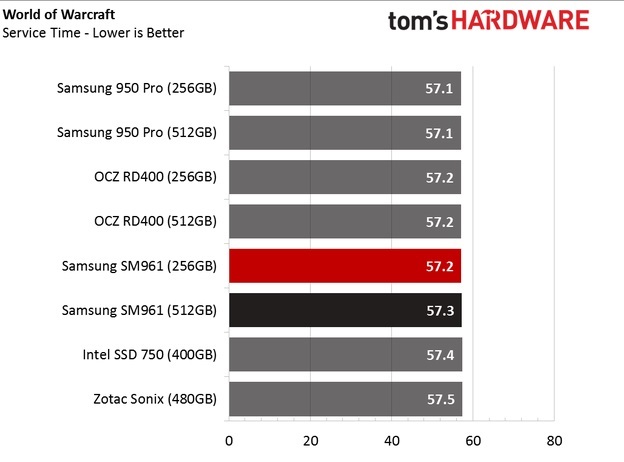

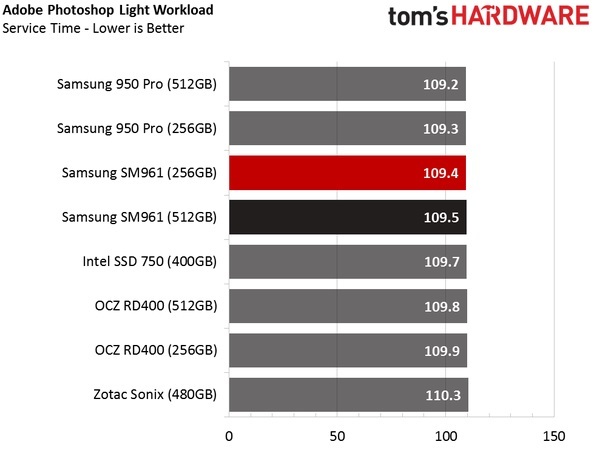
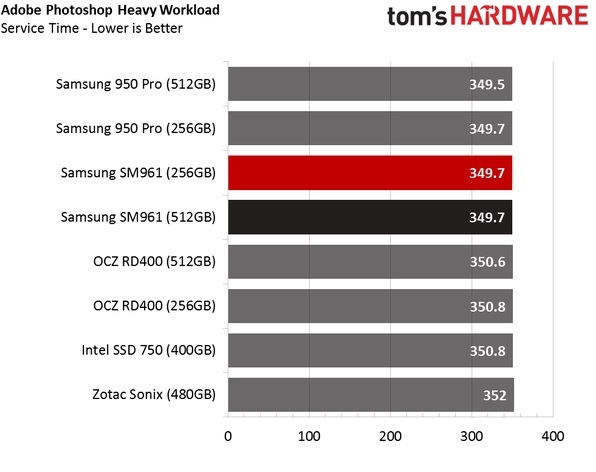
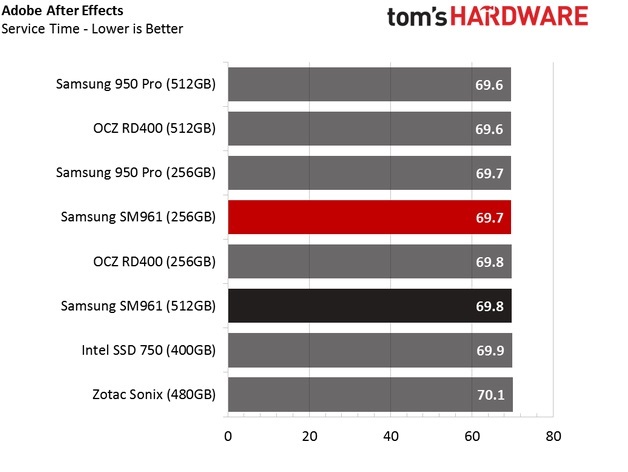
Samsung SM961 drives have not become leaders in our software performance tests, as you might expect. We checked the disks using the Microsoft NVMe driver built into Windows 8.1. The 950 Pro comes with Samsung's dedicated NVMe driver, which improves performance, but the driver will not install with the SM961. We also tried the HP NVMe INF drivers from other Samsung NVMe products with only a slight increase in performance compared to the SM961 1TB.
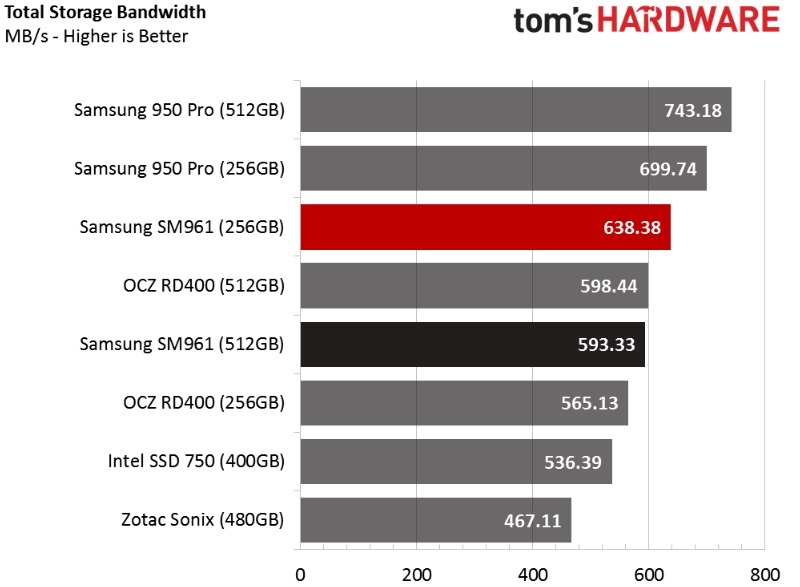
The SM961 SSDs are located near the 950 Pro, but are desperate for a driver update to overtake it. We turned to Samsung Semiconductor to get the NVMe driver for the Polaris controller, but we were told that we were using Microsoft drivers at the moment. Over time, we will see a driver configured specifically for the SM961. There are only drivers with this SSD from Lenovo, but the P70 and X1 Carbon Gen 4 do not include a list of drivers supported by SM961. We will monitor and report on new test results as soon as a new driver appears.
To find out how we experience high workload productivity, please click here .
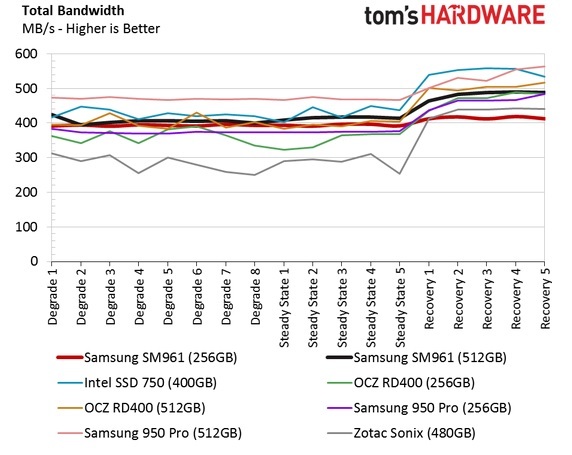
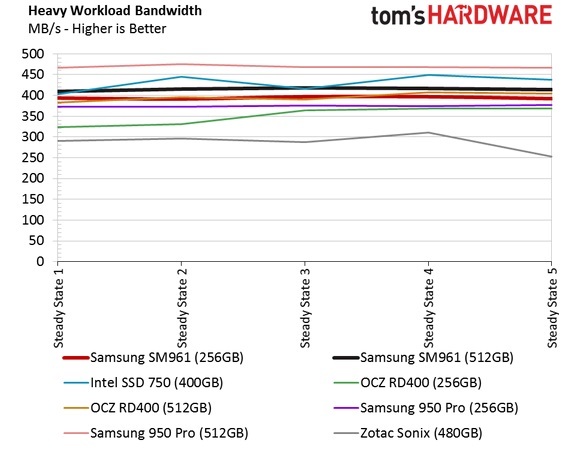
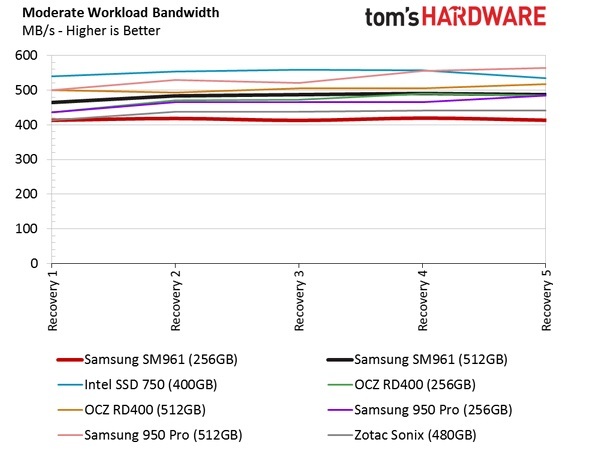
Performance issues for SM961 in real-world software applications appear in high to moderate workload tests. Both SM961 SSDs need more time than our test allows to restore maximum performance. A small amount of over-provisioning will improve performance with the new 48-layer NAND memory in these low-capacity SSDs. And as a compromise, the user can manually assign a spare area during the formatting process, but at the same time lose some of the performance.
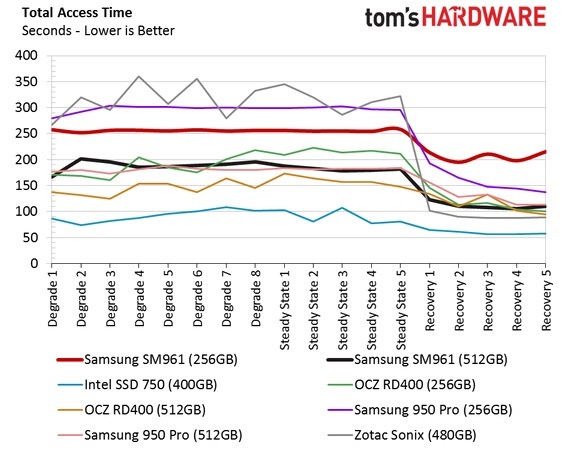
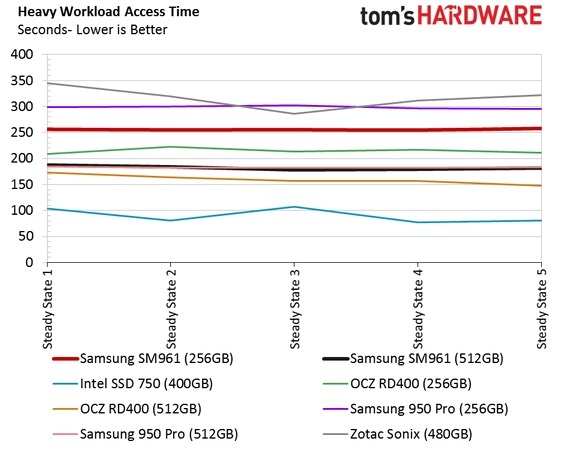
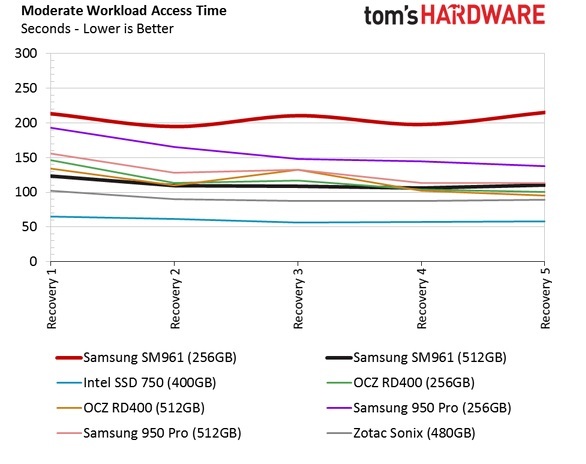
The Intel SSD 750 is delayed and also uses the largest backup space (full 112GB). The SM961 512GB is slightly superior to the 950 Pro 512GB in many recovery tests, but the SM961 256GB lacks enough parallel read and write speeds to overtake the 950 Pro 256GB.
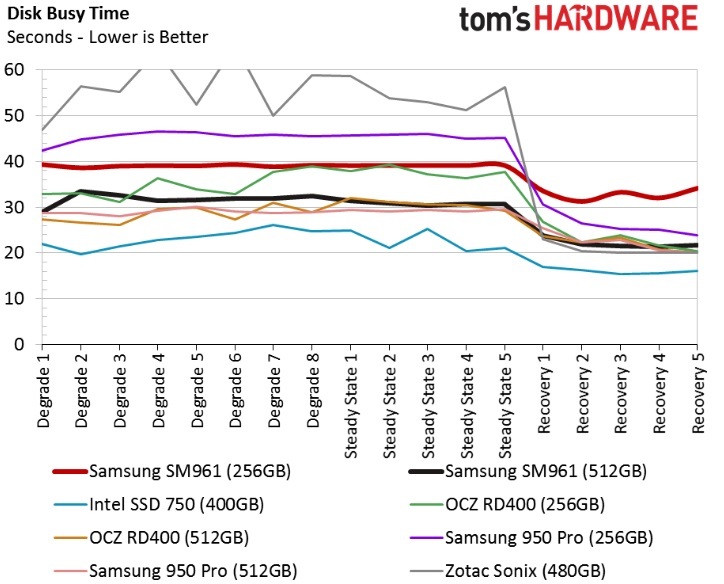
Perhaps many readers are not familiar with measuring disk usage time. The SSD goes into action when an input / output request arrives in the drive. The SSD completes the task as quickly as possible, and then goes back to inactive. “Busy Time” is the length of time from request to completion (if at least there is an external 1 I / O connection). SSDs typically use less power when they can complete the task and quickly go back to idle.
SM961 and 950 Pro 512GB show almost identical results in this test. The SM961 256GB performs the test slightly better at high loads compared to the 950 Pro with the same power, but it loses its advantage as soon as the load decreases.
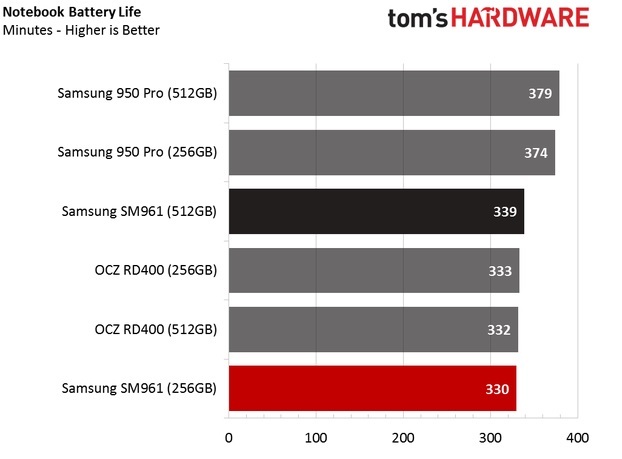

Our new Lenovo Y700 laptops allow you to test NVMe SSDs with MobileMark Bapco 2014. Many of the M.2 SSDs provide about 330 minutes of battery life during an office application test. In the Samsung 950 Pro, NVMe SSDs provide approximately 40 minutes of battery life than other SSDs and show better ratings than the performance of the SM961 during the test.
If you already have the 950 Pro, or its fellow SM951, I see no reason to buy the new SM961, unless you are looking for an SSD with more capacity. Prior to this drive, the lowest price for a 1TB NVMe SSD was $ 770. Samsung's aggressive pricing policy for the SM961 will certainly make upgrading to 1 TB more acceptable.
The two smaller SM961 SSDs we tested today also reduce entry costs. The SM961 256GB for less than $ 160 is a great deal that competes with the premium SATA SSD. Price parity with SATA 6Gb drives is a good way to drive NVMe sales. The same can be said for the SM961 with 512GB of memory, but we're still talking about $ 280.

Both tested SM961 SSDs do not show a large increase in performance for the user, and 950 Pro SSDs provide slightly higher performance in some real applications. The difference in productivity is relatively small and not sufficient to bridge the price gap. You should not rely on firmware updates, since most of them will come from unauthorized sources due to the status of OEM-SM961. We believe that the SM961 will be able to offer more in the future after flashing the flash or updating the NVMe driver.
In any case, the prices speak for themselves; the SM961 provides the best return on investment in high-performance computing.
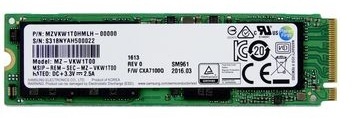
The Samsung SM961 SSD series, in our opinion, has an excellent price-performance ratio. 256Gb and 512Gb drives look very attractive, but we expect additional performance optimization in the future, as well as software support, including Samsung Magician software. RUVDS
company , following the global trend of lower prices for SSD also announces a reduction in prices. Until the end of summer, we will reduce prices by 40% for SSD drives on RUVDS virtual servers .


Today we compare the SM961 512GB and 256GB with other NVMe-based products. The two discs that we are testing today are cheaper than the discs on the market, but still they do not dominate in all categories of performance.
Contents
Price, Warranty, and Accessories
Four-Point Performance Testing
Conclusion
| SM961 128GB | SM961 256GB | SM961 512GB | SM961 1024GB |
 |  |  |  |
| N / a | $ 159.00 | $ 280.00 | $ 512.00 |
| Controller | Controller | Controller | Controller |
| Samsung Polaris | Samsung Polaris | Samsung Polaris | Samsung Polaris |
| DRAM | DRAM | DRAM | DRAM |
| Samsung LPDDR3 | Samsung LPDDR3 | Samsung LPDDR3 | Samsung LPDDR3 1GB |
| Nand flash | Nand flash | Nand flash | Nand flash |
| Samsung MLC 3rd Gen V-NAND | Samsung MLC 3rd Gen V-NAND | Samsung MLC 3rd Gen V-NAND | Samsung MLC 3rd Gen V-NAND |
| Protocol | Protocol | Protocol | Protocol |
| NVMe | NVMe | NVMe | NVMe |
| Form factor | Form factor | Form factor | Form factor |
| M.2 2280 Single-Sided | M.2 2280 Single-Sided | M.2 2280 Single-Sided | M.2 2280 Single-Sided |
| Sequential read | Sequential read | Sequential read | Sequential read |
| 3,100 MB / s | 3,100 MB / s | 3,200 MB / s | 3,200 MB / s |
| Sequential write | Sequential write | Sequential write | Sequential write |
| 700 MB / s | 1,400 MB / s | 1,700 MB / s | 1,800 MB / s |
| Random read | Random read | Random read | Random read |
| 330,000 IOPS | 330,000 IOPS | 330,000 IOPS | 450,000 IOPS |
| Random write | Random write | Random write | Random write |
| 170,000 IOPS | 280,000 IOPS | 300,000 IOPS | 320,000 IOPS |
| Endurance | Endurance | Endurance | Endurance |
| N / a | 3 Years (RamCity) | 3 Years (RamCity) | 3 Years (RamCity) |
Samsung has released the SM961 NVMe SSD for OEMs in four capacities from 128GB to 1024GB (1TB). Of these, we expect that only three will be available, since we think we should not wait for too many sales of SM961 drives with 128GB. Samsung did not release the 128 GB version of the 950 Pro, which made sense, because this product is only for enthusiasts and experienced users.
Samsung's new Polaris controller is at the heart of all SM961 SSDs, paired with a new 48-layer MLC NAND V-shaped memory cell. Many of the 850 EVO SSDs migrated to the NAND's 48-layer TLC VLC memory slot and the T3 portable SSD also comes with it, so this is the first product to ship with Samsung’s latest 3D Flash with MLC. A flash with 48 layers is the first such disk with a capacity of 256 Gbit, and it should reduce the price of existing SSD-drives, and also provides Samsung the ability to make new drives with high bandwidth.
Today we look at the 256GB and 512GB models, which, according to the manufacturer, give higher than 3100 MB / s sequential read speed. The 256GB drive reaches up to 1400 MB / s sequential write speed while 512GB gives up to 1700 MB / s. The arbitrary read speed of the SM961 is 330,000 IOPS, while the random write speed is 280,000 for the 256GB model and 300,000 for the 512GB model.
Price, Warranty and Accessories
Samsung SM961 does not produce the department responsible for the 950 Pro and other retail products. It is being developed by the Samsung SSI Group, which makes products for OEMs and major system integrators such as Dell, HP and Lenovo. Large companies get access to SSI products earlier, but over time, SSDs leak through distributors and then to intermediaries. This circuit is commonly known as the “channel”.
Australia, namely Ram City, has a history of launching Samsung SSI products in the retail market. The SM961 256GB sells for $ 159 and the 512GB for $ 280, both of which are cheaper than the price of the flagship 950 Pro, Samsung NVMe's retail product. Pricing SM961 is also tied to the Australian dollar, so prices are subject to change. The prices that we give in this article were given to us before considering the SM961 with 1TB. Since then, the Australian dollar has lost 10 percent against the US dollar, thus making SM961 SSDs cheaper for US buyers.
Ram City sells the SM961 with a 3-year warranty, but since this is an OEM product, it does not come in the Samsung retail package and does not include any accessories. The company wraps the discs in an antistatic bag that goes inside a cardboard box with a foam lining. Delivery from Australia to my office in Indiana takes three to five days, depending on what time I placed the order before or after the weekend.
Gaze


All three SM961 drives we tested use the same configuration with the new Samsung Polaris controller and two NAND flash packages. Samsung just changes the amount in the package to adjust the power. The discs are all one-sided so that they fit in the thinnest spaces. Some of the new laptops only support one-sided design, as the M.2 connector sits very close to the motherboard. Drives are 80 mm long, also known as M.2 2280. The marking “2280” indicates the width (22mm) and depth (80 mm) of the SSD.
Performance testing from four angles
Compared Models


Intel 750 Series (400GB), OCZ RD400 (256GB), OCZ RD400 (512GB), Samsung 950 Pro 256GB, Samsung 950 Pro NVMe 512GB, Zotac SONIX 480GB
In this review, we focused solely on the 256 and 512 NVMe SSDs GB Such a selection will make it easier to compare the presented drives. We did not compare the SM951 model and instead give the results of the very close 950 Pro model in performance.
Both Intel and OCZ (a division of Toshiba) sell products that fall within this power range, but Intel only offers 750 SSDs at 400GB (along with 800GB and 1200GB models are not present in our graphics). Zotac Sonix has a Phison PS5007-E7 controller with 15nm Toshiba MLC NAND. Currently, the only retail SSD is available with an E7 controller.
Sequential read performance


Both SM961 SSDs deliver impressive sequential read performance that outperforms all other products in the charts, with the 1TB model doing the same. Close results are not surprising; Samsung lists all four SM961 SSDs with a difference of only 100 MB / s in workload.
Sequential write speed


The 512GB OCZ RD400 is the only graphics product that can run at the same high sequential write speeds as the SM961. The diagram also shows the RD400 with a wild drop in performance halfway through the test. The failure was due to thermal protection, but the issue of thermal protection for SM961 is clearly resolved.
Samsung SM961 256GB speed was 1400 MB / s, which is only 300 MB / s less than the 512GB model. The SM961 256GB works much better than advertised, so the difference between the two products is much smaller than expected.
Random read performance



In the SM961, SSDs raise the bar at arbitrary read speeds at shallow queue depths, and we get only a small performance boost over the 950 Pro. The SM961 hits a brick wall with about 170,000 IOPS at high queue depths. An unexpected limit led us to think that Samsung limits the performance of the firmware. We read reports about some SM961 SSDs with more than 500,000 random read IOPS by increasing the number of threads and queue depth to 256. Using multiple workers (threads) exposes several queues, but this is not a comparison of apples and apples.
Host software places external I / O requests, they add up and wait in line for service. When the request is completed, the SSD controller places the final part in the completion queue. The NVMe protocol supports up to 64,000 queues per device, and up to 64,000 commands can be added to each. The SSD maker ultimately determines how many queues and how many teams each SSD will support (they may vary). Samsung may use multiple lines at shallower depths, which might explain the early performance plateau.
Custom write speed



In the SM961, products also have a sharp plateau in the random write test. The limit comes much earlier, in this test, with a queue depth of 4. Of our four tests, random recording gives the SM961 the most trouble. This test is one workload where the new Samsung NVMe SSD cannot surpass the previous generation.
Mixed loads and stable condition
80 Percent of sequential mixed load
Our mixed load testing is described in detail here , and our tests are described here.

Even though the SM961 has the advantage of 100% sequential tests, it significantly loses them compared to mixed serial data. In the past, we have already seen this type of behavior that changes after a firmware update to increase mixed workload performance. The SM961 SSDs are still in the production stage, and we are testing with the first mass firmware. Samsung usually does not release small updates, so when a new firmware is released it will ship immediately with several updates.
Samsung SM and PM series firmware updates create other problems when buying a bare disk. Users usually receive updates from HP or Lenovo . These updates are not advertised using traditional means. As a rule, users can stumble upon an update, and then exchange information in a technical forum.
80 Percent Arbitrary Mixed Load

The SM961 256GB and 512GB perform much better with mixed arbitrary loads compared to other drives. The advantage in random read performance at shallow queue depth is evident during this test. At large queue depths, we see a performance limitation, it comes into play again only at queue depth of 16, while Intel 750 performance continues to scale. The Intel 750 uses a 9-channel controller designed for corporate use, so the result is not surprising.
Consistent stable state



The consistent steady state test shows us that Samsung’s 3D 48-layer flash provides nearly identical performance for older 32-layer flash drives. In this test, we put a lot of burden on the flash to examine the ability of the disk to process new data about dirty cells. Immersing the SSD in a stable state launches its cleaning algorithms, during such a long intensive use you can see its performance.
The SM961 and 950 Pro are devoid of any significant spare areas required for Over-Provisioning (OP). The 950 Pro 512GB delivers the highest performance in this test, but only by a small margin. The 950 Pro 512GB has twice the number of NANDs compared to the SM961 512GB, which gives it the advantage of greater concurrency and improves its performance.
Continuous random recording


The SM961 512GB SSD delivers the fastest recording performance of stationary 4KB random numbers. Zotac Sonix has 480GB peaks at a higher speed, but it cannot support performance for a very long time; it also drops severely after steady use. The Intel SSD 750 takes place between the two SM961 drives while the 256GB SM961 is located behind it.
Software Performance and Conclusion
PCMark 8 Real-World Performance Software
For more information on software performance testing methods, please click here .





Samsung SM961 drives have not become leaders in our software performance tests, as you might expect. We checked the disks using the Microsoft NVMe driver built into Windows 8.1. The 950 Pro comes with Samsung's dedicated NVMe driver, which improves performance, but the driver will not install with the SM961. We also tried the HP NVMe INF drivers from other Samsung NVMe products with only a slight increase in performance compared to the SM961 1TB.

The SM961 SSDs are located near the 950 Pro, but are desperate for a driver update to overtake it. We turned to Samsung Semiconductor to get the NVMe driver for the Polaris controller, but we were told that we were using Microsoft drivers at the moment. Over time, we will see a driver configured specifically for the SM961. There are only drivers with this SSD from Lenovo, but the P70 and X1 Carbon Gen 4 do not include a list of drivers supported by SM961. We will monitor and report on new test results as soon as a new driver appears.
PCMark 8 Advanced Workload Performance
To find out how we experience high workload productivity, please click here .



Performance issues for SM961 in real-world software applications appear in high to moderate workload tests. Both SM961 SSDs need more time than our test allows to restore maximum performance. A small amount of over-provisioning will improve performance with the new 48-layer NAND memory in these low-capacity SSDs. And as a compromise, the user can manually assign a spare area during the formatting process, but at the same time lose some of the performance.
Access time



The Intel SSD 750 is delayed and also uses the largest backup space (full 112GB). The SM961 512GB is slightly superior to the 950 Pro 512GB in many recovery tests, but the SM961 256GB lacks enough parallel read and write speeds to overtake the 950 Pro 256GB.
Disk busy time

Perhaps many readers are not familiar with measuring disk usage time. The SSD goes into action when an input / output request arrives in the drive. The SSD completes the task as quickly as possible, and then goes back to inactive. “Busy Time” is the length of time from request to completion (if at least there is an external 1 I / O connection). SSDs typically use less power when they can complete the task and quickly go back to idle.
SM961 and 950 Pro 512GB show almost identical results in this test. The SM961 256GB performs the test slightly better at high loads compared to the 950 Pro with the same power, but it loses its advantage as soon as the load decreases.
Notebook Battery Life


Our new Lenovo Y700 laptops allow you to test NVMe SSDs with MobileMark Bapco 2014. Many of the M.2 SSDs provide about 330 minutes of battery life during an office application test. In the Samsung 950 Pro, NVMe SSDs provide approximately 40 minutes of battery life than other SSDs and show better ratings than the performance of the SM961 during the test.
Conclusion
If you already have the 950 Pro, or its fellow SM951, I see no reason to buy the new SM961, unless you are looking for an SSD with more capacity. Prior to this drive, the lowest price for a 1TB NVMe SSD was $ 770. Samsung's aggressive pricing policy for the SM961 will certainly make upgrading to 1 TB more acceptable.
The two smaller SM961 SSDs we tested today also reduce entry costs. The SM961 256GB for less than $ 160 is a great deal that competes with the premium SATA SSD. Price parity with SATA 6Gb drives is a good way to drive NVMe sales. The same can be said for the SM961 with 512GB of memory, but we're still talking about $ 280.

Both tested SM961 SSDs do not show a large increase in performance for the user, and 950 Pro SSDs provide slightly higher performance in some real applications. The difference in productivity is relatively small and not sufficient to bridge the price gap. You should not rely on firmware updates, since most of them will come from unauthorized sources due to the status of OEM-SM961. We believe that the SM961 will be able to offer more in the future after flashing the flash or updating the NVMe driver.
In any case, the prices speak for themselves; the SM961 provides the best return on investment in high-performance computing.
SAMSUNG SM961 SSD

| PROS | MINUSES |
|
|
Conclusion
The Samsung SM961 SSD series, in our opinion, has an excellent price-performance ratio. 256Gb and 512Gb drives look very attractive, but we expect additional performance optimization in the future, as well as software support, including Samsung Magician software. RUVDS
company , following the global trend of lower prices for SSD also announces a reduction in prices. Until the end of summer, we will reduce prices by 40% for SSD drives on RUVDS virtual servers .

